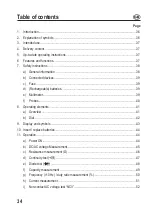
b) DC/AC voltage Measurement
The input impedance is approximately 10 MΩ and will not put much strain on the
circuit.
1. Set the function dial to the required setting:
• DC voltage measurement (V ), “DC” will show on the display.
- Short press RANGE to toggle through ranges (indicated by decimal position).
• AC voltage measurement (V ), “AC” will show on the display.
- Short press RANGE to toggle through ranges (indicated by decimal position).
2. Connect the test leads to the terminals:
- Red test lead to the
terminal.
- Black test lead to the COM terminal.
3. Connect the test lead probes to the correct test points
in the circuit:
- Red: Positive polarity “+”.
- Black: Negative polarity “-”.
4. Read the voltage values on the display.
- DC voltage measurements (V ): If a minus “-”
sign appears in front of the value, the measured
voltage is negative (or the measuring lines are
swapped).
- AC voltage measurements are given in true RMS.
A warning will sound when measured values are out of range >600 V.
5. When finished measuring, disconnect the test leads and switch the power OFF.
45
















































